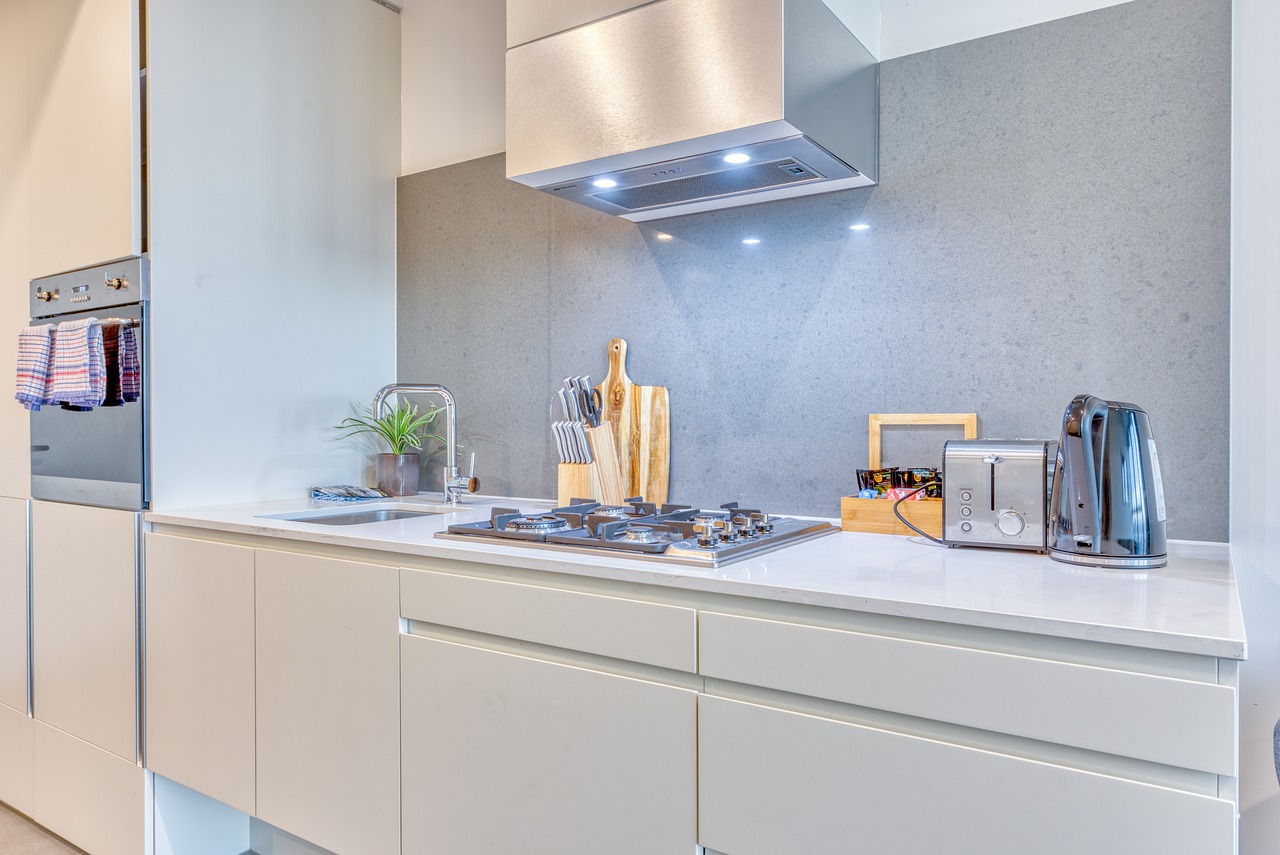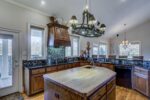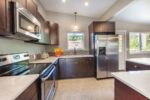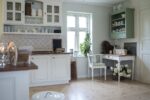Having a basic understanding of the different kitchen cabinet materials, their advantages, and disadvantages is crucial when installing new cabinets, replacing old ones, or addressing necessary repairs. Without this knowledge, it can be challenging to determine the suitable option for your kitchen. While it may be tempting to choose a material solely based on its compatibility with the home’s aesthetic, you could later discover that it lacks the durability needed to withstand the demands of a household filled with children.
If you haven’t taken the time to thoroughly research the various materials used for kitchen cabinets, you may be surprised by their cost. Stainless steel, solid wood, and even plywood are generally more expensive options, but they are also the most durable. Depending on the quality of cabinet construction, the higher cost may be worth it. To gain a better understanding of the top materials for kitchen cabinets, it would be beneficial to read this informative guide on kitchen cabinet materials.
Medium-Density Fiberboard (MDF)
Ideal for: Different styles, finishes, and budget-friendly options.
MDF, also known as medium-density fiberboard, is frequently chosen as a kitchen cabinet option due to its widespread availability. Unlike solid wood or plywood, this material has a higher density and allows for achieving a flawlessly smooth finish without any visible wood-grain. Additionally, MDF is resistant to water and mold, which makes it highly suitable for areas with high moisture content, such as kitchens.
MDF material, as well as MDF cabinetry, come in various styles and finishes, offering flexibility in design. Additionally, it can be customized to different sizes and coated with laminate to enhance its design options. Nonetheless, it is important to acknowledge that MDF cabinets are generally less durable compared to alternative materials, and exposing them to high temperatures can cause significant damage.
PROS:
Medium-density fiberboard has a smooth, even grain due to its composition of small particles of wood fibers combined with wax and resins.
Stability is ensured as MDF experiences less expansion and contraction compared to natural wood when exposed to changes in the relative humidity of your home, thus reducing the likelihood of warping.
MDF cabinets have excellent paintability and can be repainted at any time according to your preference.
Medium-density fiberboard (MDF) offers a versatile solution for crafting various styles of kitchen cabinets due to its flexible nature.
MDF comes in larger sizes as opposed to wood, which is constrained by the size of the tree it is harvested from.
CONS:
It is not possible to sand chips and scrapes out of MDF.
This cabinet material is not capable of withstanding extremely high temperatures.
Solid Wood
Ideal for: Strength, resilience, and extended longevity.
Solid wood is a popular choice for kitchen cabinetry due to its durability, making it a commonly employed material in various construction projects. It should be expected that solid wood is frequently utilized for kitchen cabinets, given its ability to endure heavy objects without warping or breaking.
In addition, opting for solid wood is an eco-friendly choice as it is usually made from sustainable resources. The only downside of using this material is that it tends to be more expensive than almost any other kitchen cabinet material, excluding stainless steel. Furthermore, due to wood’s porous attributes, it is highly vulnerable to stains, making it crucial to promptly wipe away any spills.
PROS:
Wood cabinets are always fashionable and will bring enduring elegance to your home, remaining in vogue forever.
A wide array of attractive natural colors can be found in various wood species such as bamboo, cherry, oak, birch, walnut, maple, knotty pine, and hickory.
Solid wood kitchen cabinets are considered top-notch in terms of their strength and durability. They exhibit great resilience, being robust, long-lasting, and capable of withstanding damage. Covering or removing scratches from them is typically a straightforward task.
Solid wood is easily customizable, allowing you to create the desired type of cabinet door.
CONS:
Cost. Solid hardwood cabinets have a tendency to carry a higher price tag. They are usually made with sustainable materials, which contributes to their higher cost compared to other kitchen cabinet materials.
Solid wood undergoes a natural reaction to humidity which can lead to warping or cracking. The process of expansion and contraction, commonly referred to as “breathing”, occurs due to fluctuations in temperature and humidity. However, significant moisture or an extended duration would be required for warping to occur.
To ensure durability, it is important to apply a water-resistant coating on wooden cabinets. Utilize specialized non-abrasive cleaning products specifically formulated for wood when maintaining their cleanliness.
Plywood
Ideal for: Lightweight construction, simple maintenance, and moderate level of durability.
Plywood presents a great option for individuals seeking kitchen cabinets that are strong and long-lasting, but do not wish to spend extra on stainless steel or solid wood. It is a lightweight material that offers durability, making it an ideal choice for constructing kitchen cabinets. Moreover, plywood is easy to handle, shape, and polish, enabling convenient repairs for minor issues like chips, scratches, or dents.
Choosing plywood instead of solid wood can result in cost savings for materials. However, it should be noted that plywood is costlier compared to various wood substrates or manufactured wood products. Therefore, if price is a crucial consideration, it may be wiser to opt for a more economical alternative. Furthermore, if plywood is not carefully chosen for the project, there is a possibility of encountering knots, gaps, and thinner planks that might not withstand excessive load on the cabinet.
Stainless Steel
Ideal for: Longevity, ability to withstand high temperatures, strong resistance to water damage, and effortless upkeep.
While stainless steel may not be a common choice for kitchen cabinets in residential settings, it is widely employed for constructing cabinets in commercial kitchens because of its exceptional endurance, longevity, and effortless cleaning. The sleek metal surfaces can be easily wiped to eliminate any dirt, grime, oil, or other forms of debris.
A notable advantage of stainless steel is its exceptional heat and water resistance, ensuring that individuals can use hot pans or wet cookware without concerns about inadvertently harming the kitchen cabinets. Nevertheless, the significant drawback lies in the expensive cost of stainless steel kitchen cabinets, coupled with their distinctive and specialized style.
PROS:
Stainless steel is widely chosen in commercial kitchen cabinet materials due to its durability. It exhibits excellent resistance to heat and is non-porous, ensuring no retention of water or any other liquids.
Maintenance of stainless steel kitchen cabinets is simple as they are effortless to clean. The stainless steel material’s sleek surface prevents the accumulation of stains or dirt, allowing for quick wiping of any grime, oil, or other debris.
These items have a long-lasting nature, remaining unaffected by high heat or humidity conditions, and maintaining their original appearance regardless of the ambient temperature or humidity.
Stainless steel is non-toxic, resistant to bacteria and corrosion, as well as being hygienic.
CONS:
Not every house can effortlessly incorporate the “commercial” appearance provided by a stainless steel kitchen cabinet material, making it a unique and specific style choice.
The cost of stainless steel cabinets can differ significantly, however, a complete kitchen constructed with this material will be more expensive than the more affordable alternatives.
Fingerprints are highly visible. Although the material is easy to clean, it is also prone to easily showing fingerprints, smudges, and other marks. Therefore, regular cleaning is necessary to maintain a neat appearance.
Particleboard
Ideal for those looking for inexpensive options, a lightweight structure, and resistance to staining.
Particleboard is the most economical option for constructing kitchen cabinets. It is composed of compressed wood chips, but doesn’t possess the same durability and density as MDF or HDF. Because of its limited strength, it is unable to withstand heavy loads without bending or flexing under their weight.
Particleboard has a limited ability to hold screws, deteriorating rapidly with multiple attempts. Therefore, it is commonly employed for the interior of kitchen cabinets instead of the doors. This precautionary measure aims to prevent the doors from being pulled off by heavy forces. The affordability of particleboard as a kitchen cabinet material is directly related to its performance.
Melamine
Ideal for: Withstanding water, heat, stains, and lasting durability.
With its ability to resist peeling or delamination, melamine boards offer exceptional durability for the construction of kitchen cabinets. This engineered wood material is produced through the use of heat and pressure, which securely bonds a decorative resin-infused melamine paper onto an MDF or particleboard substrate.
Opting for melamine boards as the material for constructing a kitchen cabinet is a commendable choice due to its affordability in comparison to solid wood or plywood, while still ensuring durability. Moreover, this kitchen cabinet material possesses resilience against water, heat, stains, and warping, guaranteeing that the cabinet will maintain its excellent condition for many years of frequent usage.
PROS:
Melamine, the most cost-effective material for cabinets, is composed of pressed wood, MD, or plywood with a paper layer colored by a heat-fused melamine resin coating.
The range of colors and patterns available is vast, including a remarkably realistic faux wood grain and textured melamine choice.
Maintenance is minimal with melamine cabinets as they are simple to clean and do not need to be re-stained or sealed throughout the years.
Melamine is known for its exceptional stability, remaining unaffected by humidity fluctuations unlike hardwood kitchen cabinets which may expand or contract.
CONS:
There is a limited variety of shapes available for cabinets, typically square, which restricts your range of design possibilities.
It is particularly challenging, if not impossible, to repair scratches and dents on melamine cabinets due to their high susceptibility to such damage.
Melamine has a higher weight compared to pricier cabinet materials, which could potentially result in sagging.
Wood Veneer
Ideal for: Achieving a wood-like look, having a lightweight structure, and being effortless to maintain.
Wood veneers are created by peeling or cutting a slender piece of solid hardwood, allowing them to keep an appealing, natural wood look without the expensive price of solid wood kitchen cabinets. Following the removal of the strip from the solid hardwood, the wood veneer is affixed to plywood, MDF, or particleboard, forming wood-like panels that imitate the visual aspects of solid wood.
Although wood veneer cabinets are more durable than laminate, they are susceptible to water damage. Therefore, it is important to ensure that cups, cutlery, bowls, and other dishware or cookware are dried before placing them in these cabinets. Additionally, this material is a thin and lightweight option that resists warping and can be easily maintained by periodically cleaning the kitchen cabinets.
PROS:
Wood veneer cabinets are a highly favored material choice for kitchen cabinets, as they produce a natural wood-like appearance. These cabinetry units consist of a thin layer of genuine wood, adhered to more affordable core materials, leading to the creation of panels that mimic the look of real wood.
The cost of wood veneer is lower compared to solid natural wood.
Simple Scratch Repair. Nicks and scratches can be simply buffed out to restore a smooth even appearance.
Wood veneer is comparably durable, exhibiting more resistance to warping than laminate but less than solid wood.
You can easily clean veneer cabinets with just a lightly dampened soft cloth, making them low-maintenance.
CONS:
Prone to water damage, an unsightly bubbling effect occurs when the veneer becomes detached from its base due to excessive moisture.
Polyester
PROS:
The price of this material, which consists of melamine mixed with pine fiber and covered in a polyester film, is a little higher compared to melamine, but it remains highly affordable.
Polyester exhibits greater resistance compared to melamine, making it an exceptionally durable material with increased scratch resistance.
There is a wide range of color and wood look options available for polyester cabinets.
CONS:
When polyester gets scratched, repairing it is not a straightforward task.
High Gloss Thermofoil
PROS:
An Appealing Look. High gloss thermofoil cabinets are made by applying a glossy vinyl coat to a base material like pine fiberboard. These cabinets effectively reflect light, resulting in a kitchen that looks brighter and more open.
To ensure effortless cleaning, simply use a damp non-scratch cloth to wipe away any smudges or marks.
HGT cabinets are resistant to fading and warping, unlike wood which typically experiences these issues.
CONS:
The reflective surface of this material exposes every fingerprint or smear, which is why homeowners with young children often opt for using it exclusively for upper cabinet doors.
Painting is challenging. It is complicated to change the color or hide scratches.
Although HGT cabinets have become more resilient compared to two decades ago, they still retain a level of susceptibility towards heat and moisture.
High-Pressure Laminate
PROS:
HPL is impact resistant; unlike melamine, it is produced using multiple layers and high pressure, making it more resilient against chips, scratches, and other damages.
The color and finish options for HPL cabinets are extensive.
This material is easily maintained as it does not need staining or finishing and can be cleaned effortlessly.
CONS:
High-pressure laminate is more expensive than melamine (although it remains cost-effective in comparison to numerous other materials).
Oak
PROS:
There is a range of options available when it comes to oak, including different varieties and appearances offered by the two main types – red oak and white oak. Additionally, depending on your preference for the natural wood grain look, you can opt for knotty or regular oak.
Because it is extremely durable and resistant to rot, oak is an excellent option for a kitchen, where messes are likely to occur.
In terms of price, Oak is a relatively affordable choice in comparison to other types of solid wood materials for kitchen cabinets.
CONS:
The texture of oak is characterized by its prominent grain, which might be more than what you desire for the style of your kitchen.
Oak, like any other solid wood kitchen cabinet material, is prone to cracking as it readily expands and contracts in response to fluctuations in humidity and temperature.
Birch
PROS:
Birch’s smooth surface and simple, open grain make it a fairly clean palette to work with, allowing for easy styling.
Birch stands out as an excellent choice for your kitchen cabinets if you desire wood that is sturdy and dependable.
Birch is a suitable option for painting cabinets due to its open grain, uniform surface, and compatibility with paint, unlike some other wood species that are not well-suited for this purpose.
CONS:
There is a possibility that the stain could appear uneven. If you decide to apply a dark stain on birch, the varying absorption rates could result in a blotchy appearance. If your goal is to have a more consistent appearance, it might be advisable to choose an alternative material for your kitchen cabinets.
Birch kitchen cabinets, similar to any solid wood material, are prone to cracking as they undergo expansion and contraction in response to variations in humidity and temperature.
Choosing a Kitchen Cabinet Material
When choosing materials for your kitchen cabinets, personal preference plays a significant role, but there are other factors to consider beyond just aesthetics. Durability and strength are also crucial, especially if the cabinets will be subjected to rough handling by children or occupants. While stainless steel is a durable option commonly found in industrial kitchens, it is less commonly used in residential kitchens. Therefore, if durability is a priority, you may prefer solid wood or plywood cabinets.
It should be noted that wood substrates, wood veneers, or other forms of engineered wood for kitchen cabinets are more affordable compared to high-quality materials. For a cost-effective and manageable choice, HDF and MDF are suitable alternatives for kitchen cabinets as they are lightweight and easy to handle. Additionally, thermofoil, laminate, and melamine are inexpensive options that imitate the look of wood, allowing the kitchen to have an aesthetic appeal without breaking the bank.






